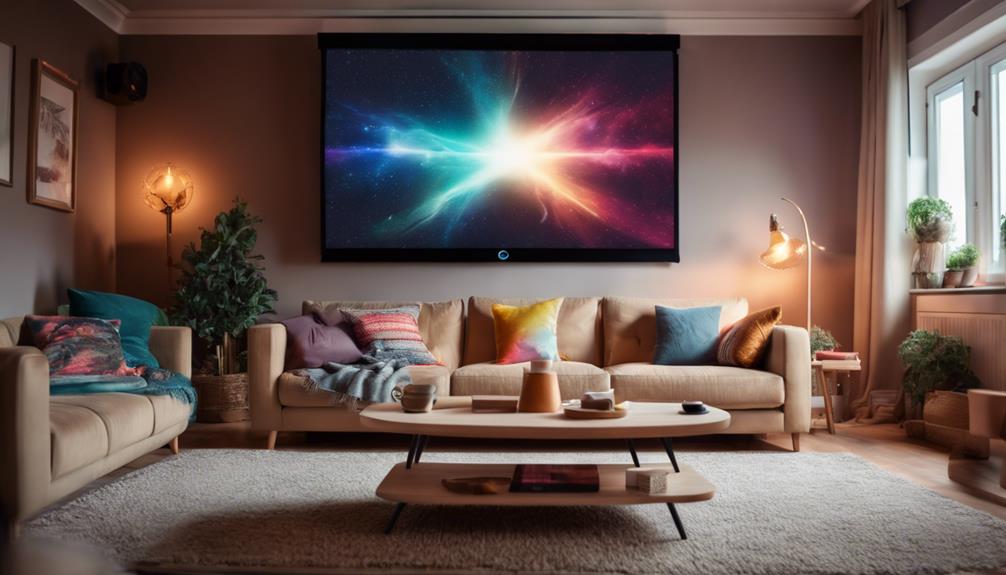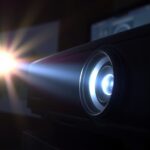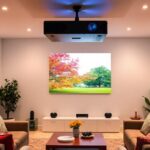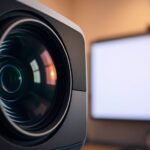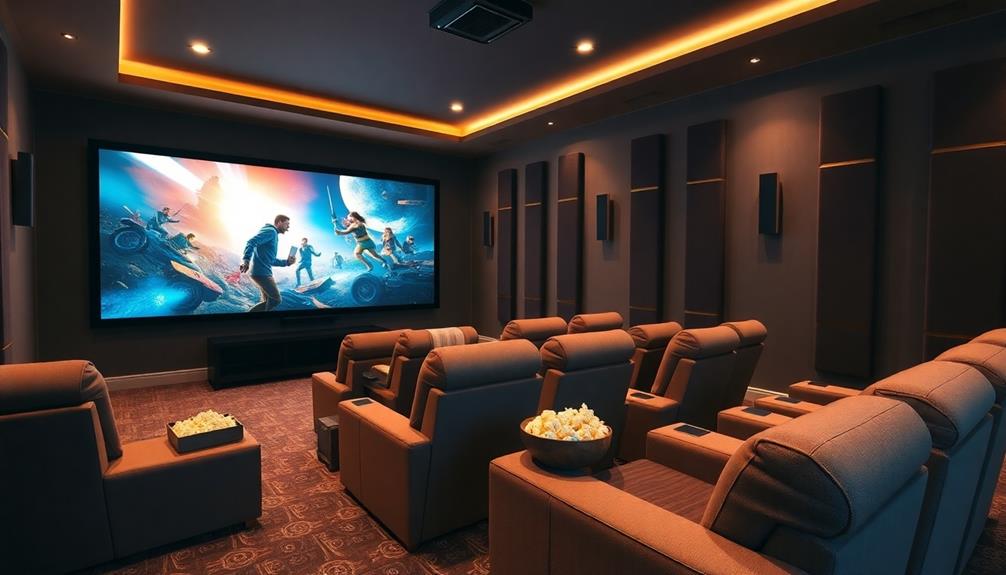When understanding projector lumens, it's essential to focus on brightness for the best viewing experience. Brightness is measured in ANSI lumens, where higher numbers indicate better visibility, especially in well-lit environments. For home theaters, aim for at least 1,500 lumens, while classrooms and conference rooms should start at 2,500 lumens. Don't forget to take into account both white and color brightness to avoid washed-out images. Factors like room size and ambient lighting greatly impact your lumen requirements. By grasping these basics, you'll enhance your projector setup and make informed decisions about your viewing needs. There's much more to explore on this topic.
Key Takeaways
- Projector brightness is measured in lumens, with higher lumens resulting in brighter images for clear visibility.
- White brightness and color brightness are both important; check both ratings for optimal performance.
- Home theaters need 1,500-2,500 ANSI lumens, while classrooms require at least 2,500 lumens for effective viewing.
- Ambient light significantly impacts lumen requirements; brighter environments need projectors with 3,000+ lumens for clarity.
Projector Brightness Basics
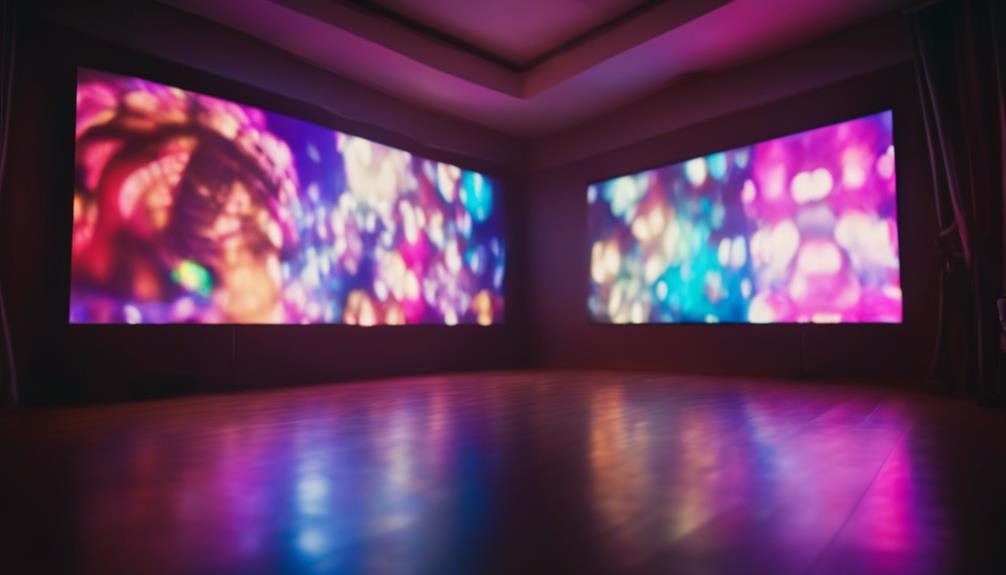
When choosing a projector, understanding brightness basics—measured in lumens—helps you select the right model for your needs.
Projector brightness is essential, especially in environments with varying ambient lighting. For home theater projectors, aim for a minimum of 1500 lumens to guarantee ideal viewing. In contrast, classrooms and conference rooms typically require at least 2500 lumens to combat bright surroundings.
You'll encounter two primary lumen specifications: white brightness and color brightness. The white brightness rating often appears higher, but keep in mind that color brightness might be considerably lower. This difference can affect how vibrant and true-to-life your images appear.
To aid your comparison of different models, look for specifications that adhere to the ISO 21118 standard for white brightness and the IDMS 15.4 standard for color brightness.
Ultimately, understanding these lumen ratings not only helps you gauge a projector's performance but also enhances your viewing experience. By considering both white and color brightness, you can guarantee that your projector delivers the clarity and richness you desire, regardless of the setting.
Importance of Color Brightness
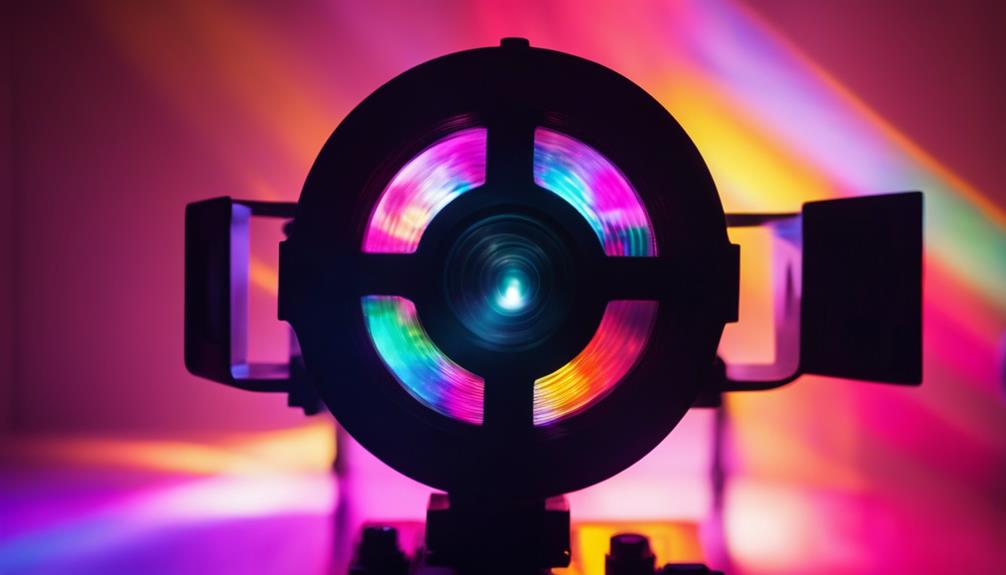
When choosing a projector, you can't overlook color brightness, as it plays an essential role in image quality.
High color light output guarantees that your images are vibrant and true to life, especially in bright environments.
Understanding the measurement standards for color brightness can help you make an informed decision and enhance your viewing experience.
Measurement Standards Comparison
Understanding the difference between color brightness and white brightness is important for selecting a projector that meets your specific needs.
When comparing projectors, it's critical to look at both measurements, as they can affect your overall projection quality greatly.
- Color brightness is measured using the IDMS 15.4 standard, guaranteeing consistency in how well projectors reproduce colors.
- White brightness, specified using the ISO 21118 standard, can often be three times higher than color brightness.
- Relying solely on white brightness can lead to poor color performance, especially in spaces with ambient light.
Understanding these measurement standards helps you make informed decisions.
A projector with high white brightness but lower color brightness may struggle to deliver the rich hues you expect, particularly in well-lit environments.
Always check both lumens ratings to verify the projector you choose will perform well in your specific setting.
Impact on Image Quality
Color brightness directly influences the image quality you experience, as inadequate levels can result in washed-out visuals that fail to captivate your audience.
When using a projector, it's vital to recognize that color brightness may be considerably lower than the white brightness specified in lumens, sometimes as low as one-third. This discrepancy can lead to poor color saturation, especially in environments with ambient light, where high color light output becomes essential.
The IDMS 15.4 standard helps you compare projectors based on their color brightness, guaranteeing you choose one that can reproduce vibrant colors effectively.
Insufficient color brightness can create washed-out images, diminishing the overall experience during presentations or movie nights. When colors are bright and vivid, viewer engagement increases, enhancing emotional responses and keeping your audience focused.
To achieve peak image quality, prioritize projectors with high color light output. This guarantees that even in challenging lighting conditions, the colors remain rich and engaging, avoiding that disappointing washed-out effect.
Brightness Requirements by Environment

To achieve ideal viewing, you'll need to take into account the brightness requirements of your environment, as different settings demand varying lumen levels. Understanding these requirements is essential for guaranteeing visibility and peak viewing experiences.
Consider these key environments:
- Home Theater: For dark rooms, aim for at least 1,500 lumens; if there's ambient light, go for 2,300 to 4,000 lumens.
- Classrooms and Conference Rooms: You'll typically need at least 2,500 lumens to cut through ambient light.
- Outdoor Settings: For movie nights under the stars, projectors should have a brightness of 2,500 to 5,000 lumens to combat external light.
Understanding ANSI Lumens
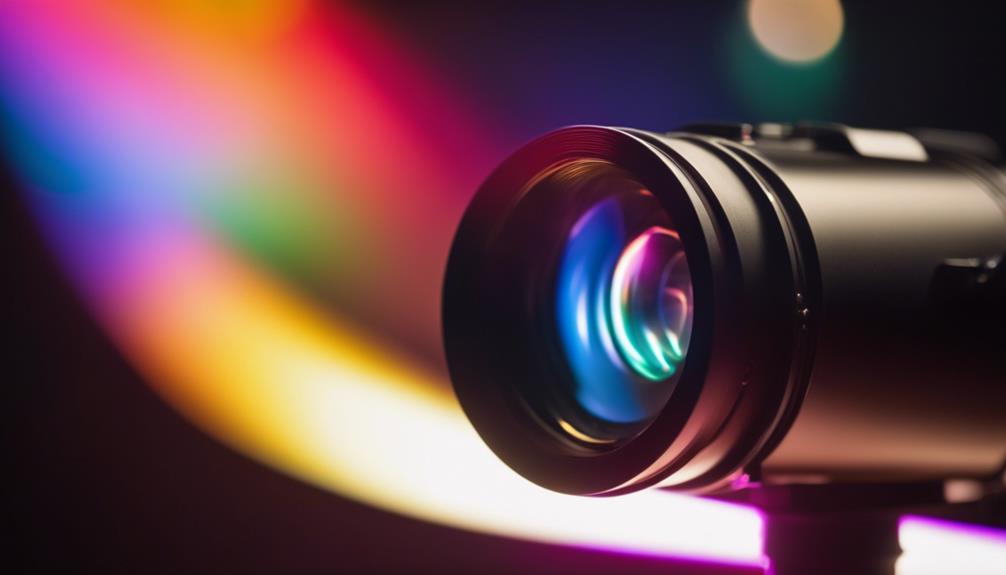
ANSI lumens measures projector brightness in a way that accurately reflects how well it performs in real-world conditions. This standardized measurement, developed by the American National Standards Institute, assesses a projector's brightness at nine different points across the screen, calculating an average for a thorough understanding of its projection performance.
When you're choosing a projector, knowing the ANSI lumens rating is essential. Typically, lamp-based models start at around 2,000 ANSI lumens, while LED and laser projectors can exceed 3,500 ANSI lumens.
Higher ANSI lumens ratings correlate directly with improved image visibility, especially in environments with significant ambient light. If you're planning to use a projector for business presentations or in classrooms, aim for models with at least 3,000 ANSI lumens.
Factors Influencing Required Brightness
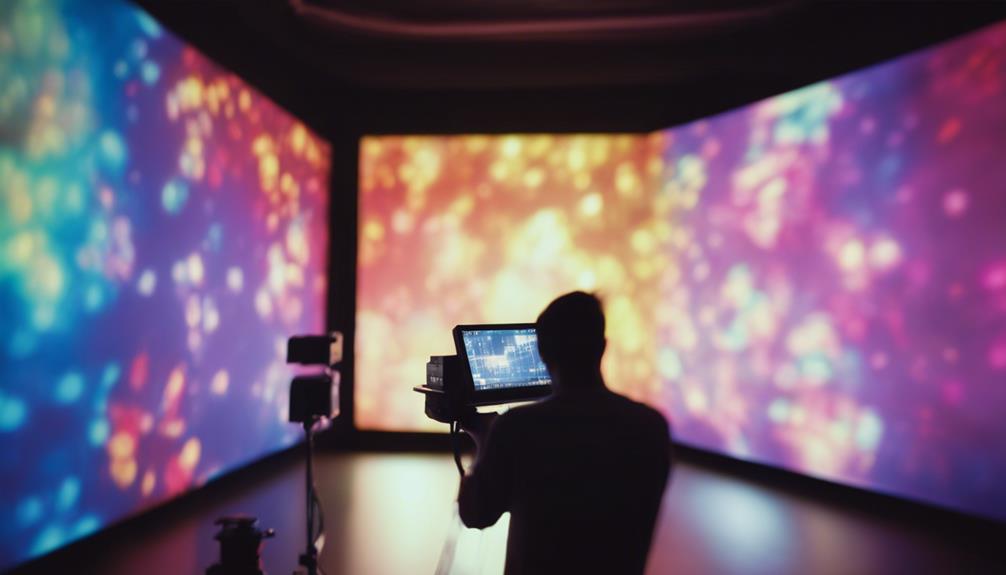
Several factors influence the brightness you need from a projector, including ambient light conditions and room size. To guarantee a superior viewing experience, consider these key elements when determining the required brightness:
- Ambient lighting: Bright environments typically demand projectors with high lumens, around 3,000 or more, while darker rooms can work with as little as 1,000 lumens.
- Screen size: A larger screen size means you'll need higher lumen output. For instance, a 100-inch screen may require 2,000 lumens in low light but 3,000 lumens in well-lit conditions.
- Room size: Bigger spaces need more lumens to distribute brightness evenly. For venues with over 50 people, projectors with 5,000+ lumens are ideal.
Projector Recommendations by Setting

When choosing a projector, it's essential to take into account your setting for the best experience.
For home theaters, you'll want something that works well in darker environments, while professional settings demand brighter options to combat ambient light.
Let's explore the ideal lumen ranges for both home and professional scenarios.
Home Theater Options
For your home theater setup, choosing the right projector brightness can greatly enhance your viewing experience based on the room's lighting conditions.
If you're aiming for ideal viewing experiences, consider the following recommendations:
- Dark Environments: A home theater projector with 1,000 to 2,500 lumens will typically suffice, ensuring clear images without distraction.
- Light-Controlled Spaces: For rooms with some ambient lighting, opt for projectors in the 2,300 to 4,000 lumens range to combat any interference.
- General Lighting Conditions: If your space has light sources, go for projectors with brightness above 2,000 lumens for the best visibility.
Professional Settings Recommendations
Choosing the right projector brightness in professional settings is essential for guaranteeing clear visibility and impactful presentations.
For small meeting rooms accommodating 1-10 people, you should look for projectors with 3,000-3,999 ANSI lumens. This range provides ideal visibility and clarity.
In medium settings like conference rooms hosting 10-50 attendees, projectors with 4,000-4,999 ANSI lumens are necessary to maintain effective presentations.
If you're working in large spaces with over 50 participants, you'll need projectors with at least 5,000 ANSI lumens to guarantee everyone can see the content clearly.
For educational settings, classrooms typically benefit from projectors in the 2,500-4,000 lumens range, which can help combat ambient light and maintain image quality.
In houses of worship, medium services often require projectors with 5,000-9,000 ANSI lumens, while larger services might need 6,000-15,000 lumens to project effectively in variable lighting conditions.
Projector Resolution and Clarity
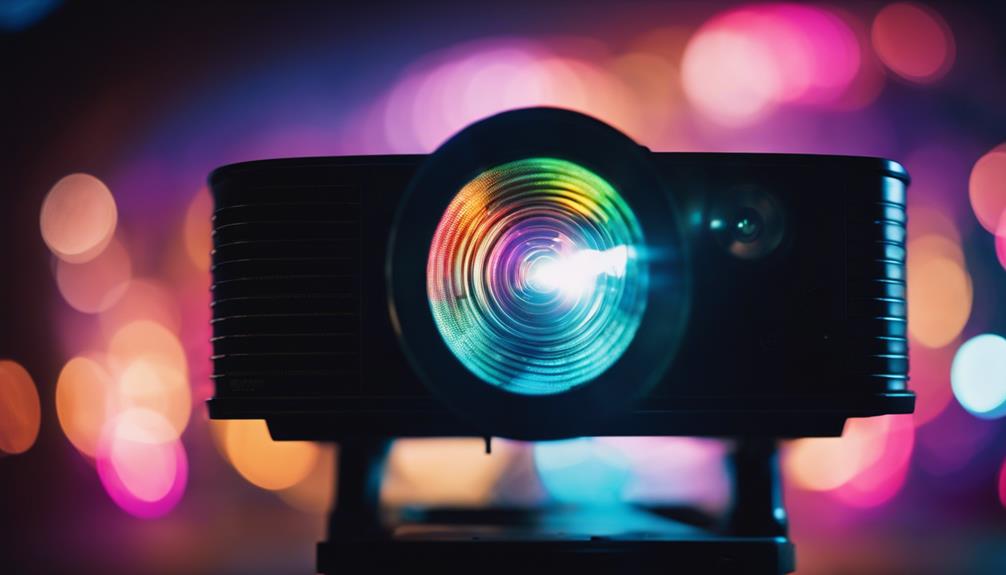
Projector resolution directly impacts how clear and detailed your images will appear, making it an essential factor in your viewing experience.
When you choose a projector, understanding the resolution is vital for ensuring image clarity and overall image quality. Here's what you need to take into account:
- Higher resolutions provide sharper images, perfect for home theaters and high-definition presentations.
- The screen size you select can determine the required resolution; larger screens typically need higher resolutions to avoid pixelation.
- Your ideal viewing distance changes with resolution; higher resolutions let you sit closer without sacrificing clarity.
If you're aiming for stunning visuals, investing in a projector with a high resolution can make all the difference.
Lower resolutions may lead to blurry images, especially with detailed content.
General Considerations for Projectors
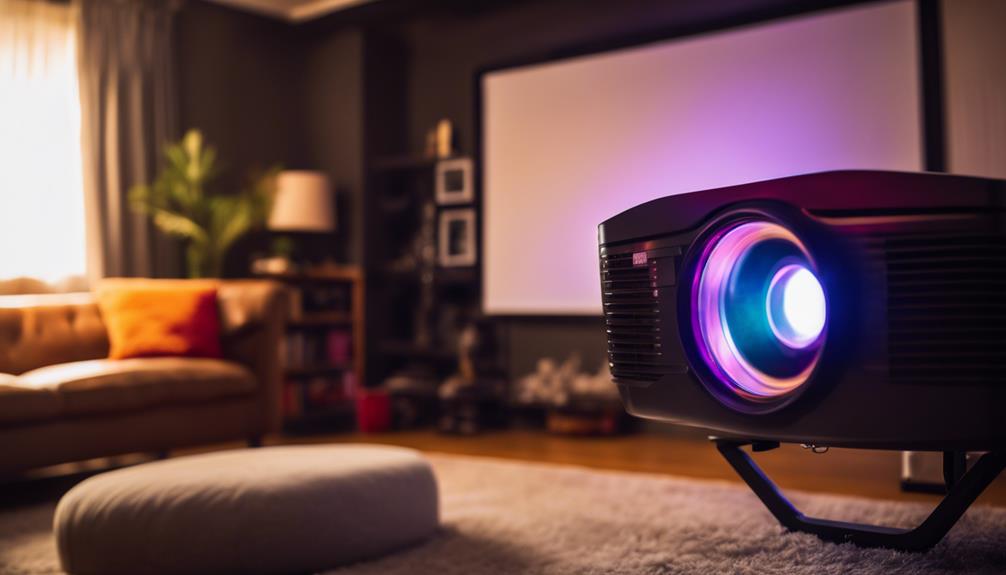
When selecting a projector, it's essential to evaluate various factors that influence performance and suitability for your specific needs. One of the most important aspects is projector brightness, measured in lumens. Higher lumens result in brighter images, vital for effective visibility, especially in environments with ambient lighting.
For home theaters, you'll typically need around 1,500-2,500 ANSI lumens for dark settings, while business presentations may require 3,000 lumens or more in well-lit rooms.
Remember that the presence of ambient light greatly affects your lumen requirements. Bright environments demand high lumens to maintain image clarity and color accuracy.
It's also important to distinguish between color brightness and white brightness; actual color brightness can be much lower than the stated lumens, which impacts overall projection quality.
Frequently Asked Questions
How Many Lumens Should a Good Projector Have?
A good projector should have at least 1,500 lumens for dark environments. For brighter settings, aim for 2,300 to 4,000 lumens. Adjust based on your specific needs for classrooms, outdoor use, or large spaces.
Is 20,000 Lumens Good for a Projector?
Yes, 20,000 lumens is excellent for a projector. It's perfect for large venues and well-lit environments, ensuring clear, vibrant images. Just keep in mind the importance of color brightness for ideal viewing quality.
Is 5000 Lumens Bright Enough for a Projector?
Yes, 5000 lumens is bright enough for most environments. It's ideal for classrooms and conference rooms, but you might find it overly bright in controlled home theater settings, washing out colors. Consider your specific needs.
How Many Lumens Do You Need to Project in Daylight?
Picture sunlight pouring in like a waterfall; to cut through that brightness, you'll need at least 3,000 lumens for clear projection. For outdoor events, aim for 2,500 to 5,000 lumens for ideal visibility.
Conclusion
To summarize, understanding projector lumens is essential for getting the best viewing experience, whether you're hosting a movie night or giving a presentation.
By considering factors like brightness needs for your environment and the importance of color brightness, you'll guarantee your projector delivers stunning visuals.
So, don't be left in the dark—choose wisely and light up your space like it's 1999!
With the right projector, you'll bring your content to life in vivid detail.

